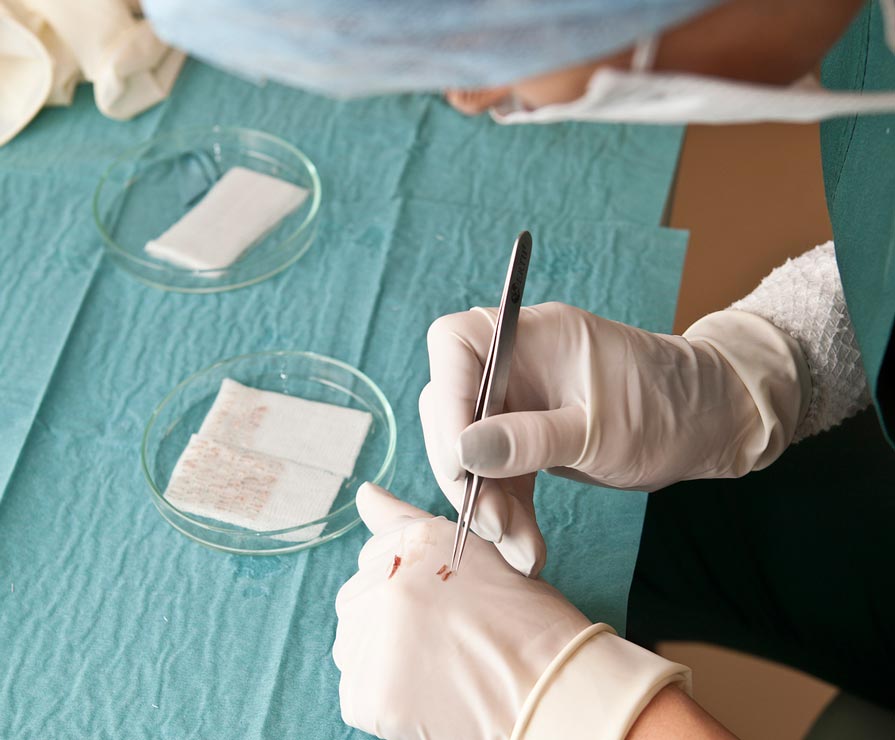Surgical Solutions for Hair Loss

Hair loss can also be treated surgically with several methods, and can significantly improve appearance in as little as a single session with an experienced surgical team. The most commonly used surgical hair loss treatment is hair transplantation, because other more invasive surgical procedures (i.e., scalp reductions or expanders and flaps) usually produce less natural-looking results. However, these are still valuable reconstructive surgery tools for severe and often permanent balding due to cicatricial alopecia, birth defects, and trauma (e.g., burns). 3, 192
Surgical hair replacement has been in use since at least the 1930s, when a Japanese doctor used the procedure to treat World War II victims with hair loss from burns. According to one survey of medical professionals, hair transplants are so popular over 80,000 patients a year in the United States alone opt for the procedure to treat their hair loss. 192
How Is Surgical Hair Replacement Done?
Surgical hair replacement procedures basically harvest tiny areas of skin with hair from the scalp and graft them to the balding areas. Typically these grafts contain 1-2 healthy hair follicles containing 1-4 hairs in total. Sometimes parts of the balding areas are surgically removed to reduce the size before grafting flaps with hair. 22
Since it is impossible to tell how much further balding will progress in an individual, hair replacement surgery is usually combined with other treatments (such as minoxidil) designed to stop any additional hair loss. This is done to help avoid the patchy look that may occur if additional hair is lost around the transplanted follicles, but patients should anticipate that they may need additional transplants in these areas. 22, 77
In addition, modernized procedures are now more carefully planned to account for future hair loss and preserving donor hair sites on the patien's scalp — including using smaller grafts. For example, since the 1980s and 1990s, micro-grafts taken by tiny incisions have replaced the larger standard punch grafting technique that often caused trauma to the donor sites. 192
Referred to as follicular unit transplantation, this new technique now allows for hair replacement in areas the larger graft techniques simply didn't work in, such as eyelashes, eyebrows, and male facial hair. It also permitted many more grafts to be done per session. 192
Although the procedure can be painful and expensive, when done by a skilled medical professional the results last a long time. And the psychological, social, and even career benefits may well be worth the temporary discomfort and monetary cost of surgery.
Is Surgery a Suitable Treatment Option for All Hair Loss Patients?
As with any invasive medical procedure, the health professional will assess each patient on an individual basis to determine the potential risks and benefits surgical hair loss treatment may offer. Even if otherwise healthy, there are certain limitations that may make hair surgery less than optimal for a particular patient. These include: 3, 24
- Not enough appropriate donor sites
- Damaged skin at areas of hair loss
On the other hand, surgical hair replacement may actually be an option for patients who may not have thought they were eligible because of inflammatory and/or autoimmune conditions that can cause permanent, scarring hair loss . As long as the causal condition has been treated and is dormant, physicians may be able to surgically graft hair or reduce balding areas by removing sections of the scalp. The risks are that the condition may recur, the surgery itself could possibly trigger a recurrence, and that hair grafts may not take as well as in normal skin. However, many successful transplants have been done in patients with cicatricial hair loss. Even if hair replacement is not an option, doctors can remove scar tissue and surgically drain lesions caused by underlying condition in order to improve appearance.


